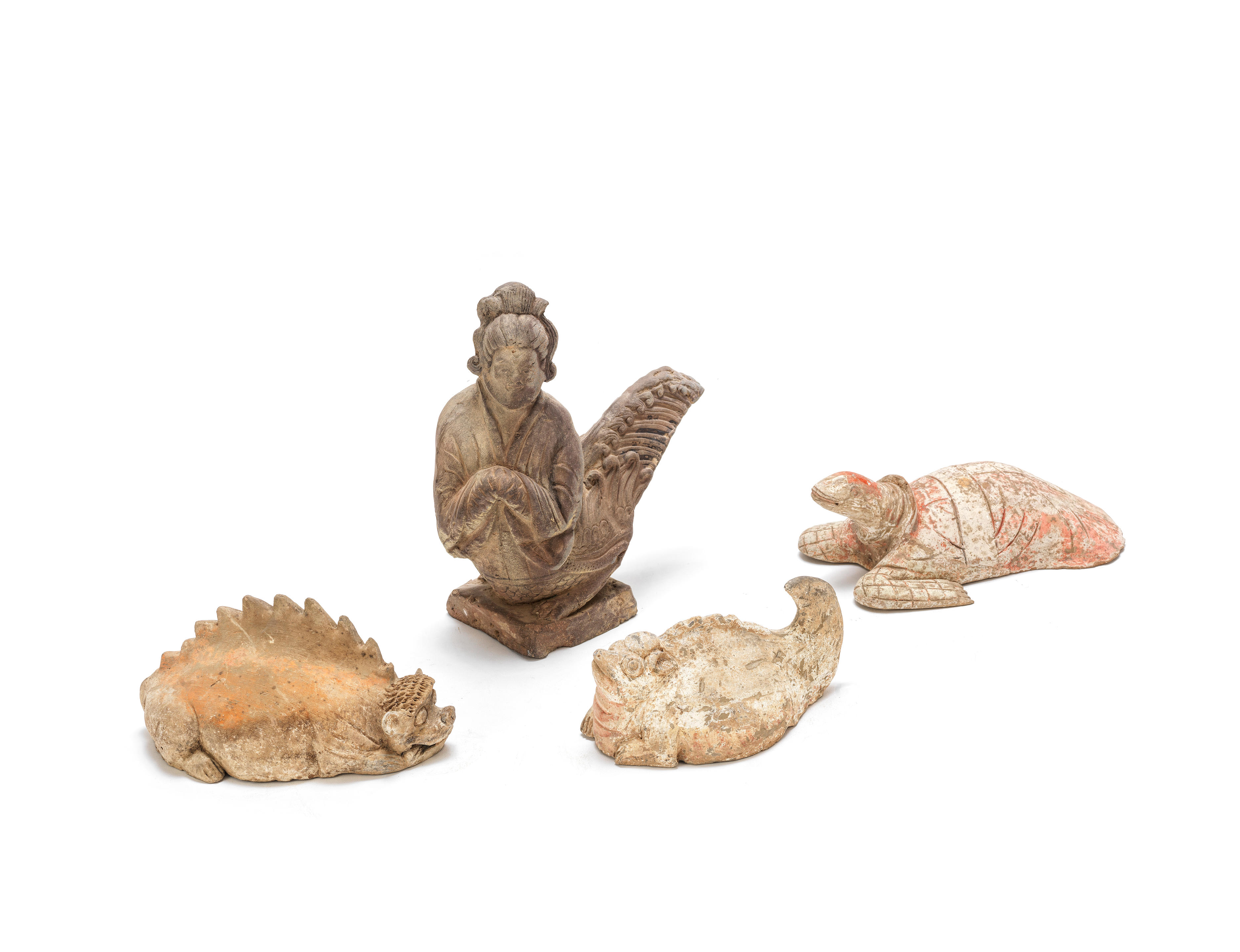Three Tang dynasty models of seated attendants and musicians, respectively, 20cm, 19.5cm and 14.7cm high, Tang dynasty Oxford TLT tested Provenance: The Estate of Barry Flanaghan. 唐 彩陶俑三件 LIFE WITHIN A TANG DYNASTY TOMB Benedetta Mottino Pottery figures of attendants and musicians, such as those presented in this lot, were, in tombs dating to the Tang dynasty, incorporated within a complex of furnishing aimed at presenting the deceased with a miniaturised universe where they were deemed to continue their post-mortem existence. This way, elaborate brick built, underground, chambered, burials, were constructed for the highest-ranking members of the society in Tang China and decorated in a way to suggest an earthly and a heavenly realms. Accordingly, a courtly architectural compound was presented on the lower register of the tomb walls through painted receiving halls, garden settings, inner quarters, and complemented with official gatherings, attendants, entertainers, horses, camels, and daily utensils. On the upper portion of the tomb walls, namely the vaulted tomb passageway and the domed ceiling of the burial chamber, a heavenly environment was suggested by the multiple floral combinations, alternating with scrolling clouds, the mythical Animals symbolising the Four Directions and detailed star maps including the sun, the moon and the Milky Way. The underlying principle to the understanding of such elaborate burials was the living’s preoccupation with providing the deceased with an inhabitable compound where they, as in life, continued to receive the care and worship, so they could ascend to and connect with Heaven, responsible for all things on Earth, to propitiate its benign conduct towards their living offspring. Ancestors in China were in fact believed to be active participants to the life of the living, which they could positively affect if provided with continuous sustainment. Assuring the dead a continued care, therefore, was the premise leading to a successful afterlife. As Jessica Rawson argued, images in the tombs were believed to function just like their physical counterpart and thus perpetuate their benign effects. For this reason, therefore, the content of the tombs and its overall arrangement were not only indispensable for the Han Chinese to maintain and extend their understanding of the afterlife, but also serve as indicators for understanding the social and ideological contexts of the society for which these tombs were constructed. Jessica Rawson, Chinese burial patterns: sources of information on thought and beliefs, in Renfrew, Colin and Chris Scarre (eds.), “Cognition and material culture: the archaeology of symbolic storage”, 1998, p. 107-131. Jessica Rawson, The power of images: the model universe of the First Emperor and its legacy, in Historical Research 75, May 2002, p.123-154 Jessica Rawson, Changes in the representation of life and the afterlife as illustrated by the content of tombs of the T’ang and Song period, in Smith, M. K. H. a. J. G. (ed.), Arts of the Sung and Yuan (New York: Metropolitan Museum of Art), 1996, p. 23-43. Condition report disclaimer
Three Tang dynasty models of seated attendants and musicians, respectively, 20cm, 19.5cm and 14.7cm high, Tang dynasty Oxford TLT tested Provenance: The Estate of Barry Flanaghan. 唐 彩陶俑三件 LIFE WITHIN A TANG DYNASTY TOMB Benedetta Mottino Pottery figures of attendants and musicians, such as those presented in this lot, were, in tombs dating to the Tang dynasty, incorporated within a complex of furnishing aimed at presenting the deceased with a miniaturised universe where they were deemed to continue their post-mortem existence. This way, elaborate brick built, underground, chambered, burials, were constructed for the highest-ranking members of the society in Tang China and decorated in a way to suggest an earthly and a heavenly realms. Accordingly, a courtly architectural compound was presented on the lower register of the tomb walls through painted receiving halls, garden settings, inner quarters, and complemented with official gatherings, attendants, entertainers, horses, camels, and daily utensils. On the upper portion of the tomb walls, namely the vaulted tomb passageway and the domed ceiling of the burial chamber, a heavenly environment was suggested by the multiple floral combinations, alternating with scrolling clouds, the mythical Animals symbolising the Four Directions and detailed star maps including the sun, the moon and the Milky Way. The underlying principle to the understanding of such elaborate burials was the living’s preoccupation with providing the deceased with an inhabitable compound where they, as in life, continued to receive the care and worship, so they could ascend to and connect with Heaven, responsible for all things on Earth, to propitiate its benign conduct towards their living offspring. Ancestors in China were in fact believed to be active participants to the life of the living, which they could positively affect if provided with continuous sustainment. Assuring the dead a continued care, therefore, was the premise leading to a successful afterlife. As Jessica Rawson argued, images in the tombs were believed to function just like their physical counterpart and thus perpetuate their benign effects. For this reason, therefore, the content of the tombs and its overall arrangement were not only indispensable for the Han Chinese to maintain and extend their understanding of the afterlife, but also serve as indicators for understanding the social and ideological contexts of the society for which these tombs were constructed. Jessica Rawson, Chinese burial patterns: sources of information on thought and beliefs, in Renfrew, Colin and Chris Scarre (eds.), “Cognition and material culture: the archaeology of symbolic storage”, 1998, p. 107-131. Jessica Rawson, The power of images: the model universe of the First Emperor and its legacy, in Historical Research 75, May 2002, p.123-154 Jessica Rawson, Changes in the representation of life and the afterlife as illustrated by the content of tombs of the T’ang and Song period, in Smith, M. K. H. a. J. G. (ed.), Arts of the Sung and Yuan (New York: Metropolitan Museum of Art), 1996, p. 23-43. Condition report disclaimer















Testen Sie LotSearch und seine Premium-Features 7 Tage - ohne Kosten!
Lassen Sie sich automatisch über neue Objekte in kommenden Auktionen benachrichtigen.
Suchauftrag anlegen